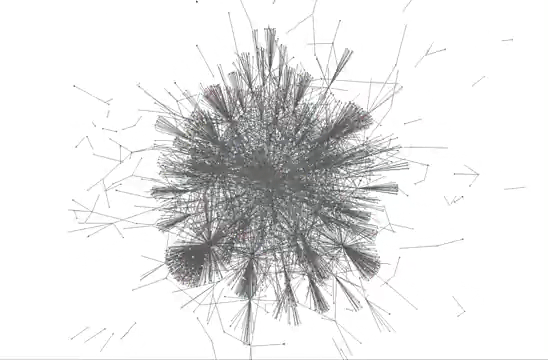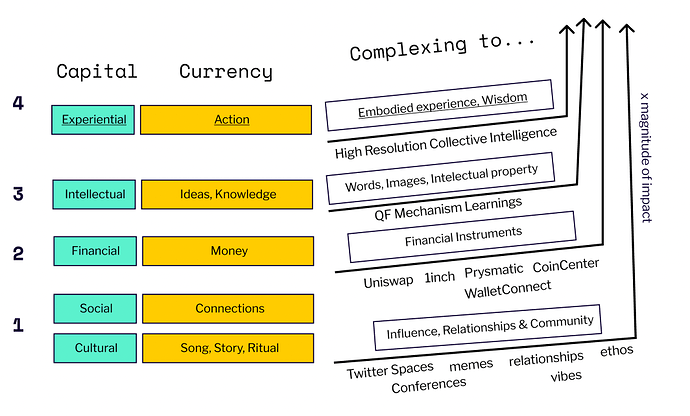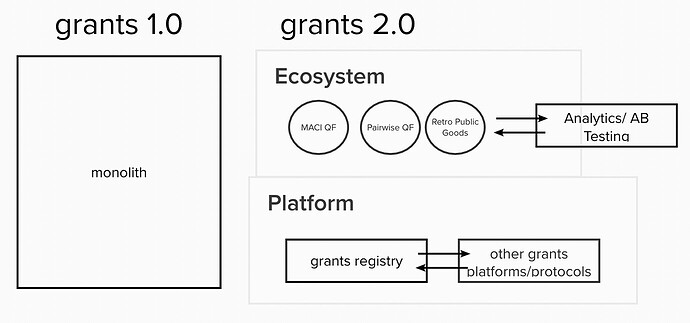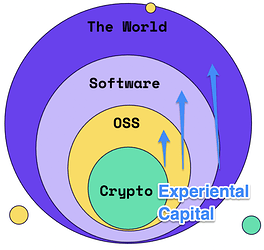TLDR
- Grants 1.0 is centralized & therefore has an upper limit to its growth.
- Grants 1.0 is going into maintenance mode.
- We can reduce fragility & scale our impact with Grants 2.0
- I explore what that world looks like & attempt to build common understanding & consensus about that direction.
- Thanks to everyone whos helped us get to this point of understanding of our impact.
Grants 2.0 is how we scale our impact 
Hi everyone,
This post is about why I think GitcoinDAO should considering going all-in on Grants 2.0.
All-in on Grants 2.0

In explaining why, I want to talk first about Grants 1.0.
It’s not the future.
It’s open source but it’s not decentralized. It’s not forkable. It’s not well documented. It’s primary instance is hosted by a centralized company on AWS in Oregon.
Because of these things, it can’t be the future of GitcoinDAOs Impact.
To drive home the immediacy of this point, I want to highlight this line from the recent Grants 2.0 Vision post by @lthrift @kevin.olsen (VP Product, VP Engineering at Gitcoin Holdings respectively) :
Starting immediately after GR13 the Gitcoin.co web application will effectively go into maintenance mode.
For those of us skilled at reading between the lines, this is kind of a big deal.
The application that has powered $52mm worth of OSS funding so far, through 13 rounds is going into maintenance mode!
While in maintenance mode, new features for this codebase will not be considered (though bug reports will triaged).
That’s kind of a big deal. It definitely marks the beginning of the end of an era.
So why do this now? Why make a first move towards retiring the primary application behind Gitcoin Grants?
Reason 1 - Grants 1.0 has an upper limit to its impact.
The primary reason is that we are fully coming to grips with the fact that we are turning Gitcoin Grants into GitcoinDAO.
- The DAO launched,
- it ran a few rounds of Gitcoin Grants,
- now the Foundation is here.
It’s time to seriously come to terms with the fact that we can decentralize the governance of GitcoinDAO all we want, if we dont get serious about decentralizing its computation, we will not be on track to fully orient Grants out of the DAO.
Increasingly we cannot ignore the inconvenient truth that Grants 1.0 is misposiitioned for the world in which we are going. It is mispositioned because it was built for a different time.
- It was our 0 to 1 playground, built in a time when great decentralized tooling for hosting, indexing, code + data were not available, and laden with the tech & product debt of an organization trying to find it’s footing during The Great Bear and The Great Reset .
- It was built as a centralized monolith by a centralized company.
And the future of public goods funding on Gitcoin involves
- Gitcoin Grants going from 0 to 1 to 1 to 10.
- Gitcoin Grants going from a centralized monolith to decentralized, modular, and forkable protocol maintained by a DAO.
Side Effects: Other Features of the monolith
Note: Gitcoin Grant is just one product of the monolith. For the avoidance of doubt, here are the modules of the monolith, and what their futures:
- Gitcoin Grants - moving to Gitcoin Grants 2.0.
- Gitcoin Hackathons/bounties - still being run out of the maintenance mode monolith.
- Gitcoin Kudos/Quests - being retired or forked & decentralized.
- KERNEL - being spun out.
- Gitcoin Profiles - TBD but likely to be exited to ceramic data stores and POPP
Reason 2 - to make headspace for Grants 2.0
A primary reason is that it allows us all to move our focus from the current operating modes (relying on Gitcoin Holdings) to focusing on whats next, launching Gitcoin Grants 2.0 & riding it to our next phase of growth.
So whats next?
So now that we’ve decided to retire the monolith, whats next?
If one is focused on scaling GitcoinDAO’s impact for the world, how they do that? And why is Grants 2.0 an important part of that?
This is where this post intersects with my work in Articulating GitcoinDAO’s Impact on the World. As you may remember, that post explores the following question:
What is GitcoinDAO’s impact on the world?
and comes up with the following visual diagram of Gitcoin DAO’s present impact in 4 different vectors:
The cultural, social, financial, intellectual, experiental capital exports of GitcoinDAO
How do we get to our next phase?
I think our next phase of impact really hinges on whether Gitcoin Grants 2.0 is successful.
The Base Case
I the base case for our ultimate impact is for the DAO to become something like a FWB or a Seed Club - a social club where you go to build & fund digital public goods. We want to be at the intersection of theory and action, there are many places to discuss the progress being made in web3, but we also want to bring that progress to life.
Of course, we hope to see Gitcoin Grants as it exists today grow linearly via side rounds, aqueducts, and strong brand awareness in the next few seasons. But there are limits to how it can grow in the product’s Grants 1.0 form. And there are non-negligible financial overhead, intellectual overhead, centralization risks, and other overhead & fragility that are risks to continuing to operate Grants 1.0.
The base case is trafficking in Social & Cultural Capital, as growth of our Intellectual, Experiential, and Financial impact tapers off. .
The Plus Case
The plus case is the base++ case.
In the plus case, Gitcoin Grants 2.0 unlocks
- Exponentially more Financial Capital
- Exponentially more Intellectual Capital
- Exponentially more Experiental Capital
1. Exponentially more Financial Capital
In Gitcoin Grants 1.0, which was a centralized monolith which required you to contact us to run a round. We (or later, DAO workstreams) would staff an account manager who would make sure your round goes well.
This is an effective way of linearly scaling Grants.
In Gitcoin Grants 2.0, anyone can fork the codebase + accompanying documentation, ingest Grants from the registry, and run a QF round of their own. They will be able to select different matching schemes (QF or not) or identity schemes, or aesthetic/branding options, that are right for their community. They will be well supported with documentation about how to make their rounds successful. A no-code option would allow anyone to do this without technical skills.
Grants 2.0 could allow us to exponentially scale Grants.
- Grants 1.0 was Gitcoin Holdings fishing for you.

- Grants 2.0 is GitcoinDAO teaching you to fish.





2. Exponentially more Intellectual Capital
One thing I’m really excited about in Grants 2.0 is how much it could support the creation of more intellectual capital - especially learnings about different QF mechanisms (but maybe other mechanisms - I’ve got my eye on Effective Altruism + Retroactive Public Goods Funding right now - both promising non-QF mechanisms for doing good).
To understand why I’m so excited, lets look at this diagram.
Gitcoin Grants 2.0 = decentralized registry with an ecosystem of diff forkable funding mechanisms competing to deploy matching pools.
The goal is to create an environment where the community can test different public goods funding mechanisms on top of a deeply liquid registry of grants. We want to speedrun the “hill climbing problem” of finding optimal democratic mechanisms for funding public goods.

3. Exponentially more Experiential Capital
Here is what the preference map for GR13 looked like. Each node in the network is a user or a grant, and each edge is a transaction.

With this data set, we have a deeper understanding of what projects everday community members care about, a novel wisdom arising from the experiential capital of collective action.
There is an embodied intelligence in the Ethereum community’s funding preferences, and I imagine a world in which we are able to pull high resolution insights from this dataset. As Audrey Tang puts it, we want to “be a channel for greater combinations of strength & intelligence to come together”.
This embodied intelligence could grow to critical mass within the Web3/Crypto communities, but also we could expand it outwards to the rest of the world. A meta-public good, a public good that supports other public goods.
If we can create the wordpress of QF, we can scale the impact of QF exponentially. Wordpress made anyone a blogger, Grants 2.0 could make anyone into a QF ecosystem builder. I can’t tell you how many times I run into community leaders at ETHDenver this year who’s building an ecosystem who would love to have an easy to use Grants/QF product dropped into their lap.
In Closing
It is my strong recommendation that the DAO embrace Grants 2.0
My general feeling is this: We have great momentum into The Great Reset & Also The Great Revival, but I do worry that we are only on track to create only the base case of impact.
To be clear: The base case (the case in which we export social & culture capital (memes/stories) about public goods) wouldnt be so bad at all. Its so rewarding to create social schelling points for the world to come together & build/fund public goods.
But the base case isnt our fullest potential. I believe that QF is a core money lego, like AMMs, or gnosis safes, or MolochDAOs. I think there is a legitimate opportunity to ride that insight to create exponentially more social, culture, intellectual, financial, and experiential capital for our stakeholders & for the world.
My feeling is if we want the plus case, we have to build consensus on that, coordinate to pay down our centralization debt, launch Grants 2.0, make it great, scale it, teach it, watch it fly.
Getting good at building software as a DAO
Building software is hard enough itself. Doing it as a DAO is unknown art (some would say, impossible).
There have been false starts so far.
I am extremely thankful to those who have tried their hands at implementations of Grants in the past. From the initial launch, to Gitcoin Grants Round 1 to Grants Round 13, to experimenting with side rounds, and dGrants Alpha. We have learned a lot from these efforts. They have informed the direction for Grants 2.0.
One day, I hope to see large complex & mission-critical software projects run out of DAOs. Until then, Holdings is happy to pinch hit.
For now, if you would like to help Grants 2.0 be successful, please reach out to @lthrift and @kevin.olsen to see how you/your group can help. If you have questions about Grants 2.0, I invite you to bring them to an upcoming DAOVibes or comment below.



